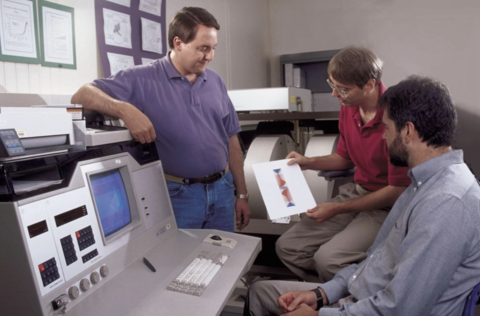NIST Micromagnetic Modeling Project Enables Research Advancements Worldwide
Dates: 1999-2022
Efforts of NIST mathematicians have greatly improved the state-of-the-art in computational modeling of magnetic phenomena at the nanoscale. OOMMF, a carefully engineered reference software system developed by NIST, is both usable and extensible, allowing it to be widely used and repurposed. It is now the most widely used nanomagnetics modeling system in the world.
Magnetic phenomena have long been exploited to enable computer memory and storage and have been used in sensors for industrial and consumer applications. The last 20 years have seen an unprecedented surge in research and innovation in this field. Examples include:
-
spintronics for nonvolatile magnetic random-access memory (MRAM),
-
magnetic quantum dots for computer logic gates,
-
magnetic skyrmions for logic devices and novel RF devices,
-
spin torque oscillators for compact on-chip tunable microwave signal sources and tunable RF filters,
-
nanomagnetic sensors in smartphones for mobile navigation, anti-theft systems and biomedical applications,
-
magnetic nanowires for biomedical applications, and
-
magneto-resistive sensing for scanning probe microscopy.
Also, advances in this field are impacting the foundations of physics. For example, studies of so-called spin ice phenomena are informing our understanding of the microscopic origin (“emergence”) of atomic magnetic moments in magnetic materials.
In each of these cases significant technological advances have been enabled using the NIST Object Oriented Micromagnetic Modeling Framework (OOMMF), a software package for the computational modeling of magnetic phenomena at the nanoscale. Such computational modeling enables the efficient exploration of new magnetic materials and phenomena. In addition, since experimentation in this field is notoriously challenging, modeling is indispensable to experimentalists, informing the design of experiments and the interpretation of results.

Originally created as reference software under the aegis of the Micromagnetic Modeling Activity Group (muMAG) co-founded by NIST, OOMMF has emerged as the most widely used nanomagnetic modeling tool worldwide. During the 15 months ending in December 2021, for example, some 9,300 downloads of the software from 5000 distinct clients were recorded. Even more significantly, to date, use of OOMMF has been cited in more than 3,300 refereed research articles. Such articles have appeared in the major journals in the field, including the Journal of Applied Physics, Physical Review, Applied Physics Letters, the Journal of Magnetism and Magnetic Materials, and the IEEE Transactions on Magnetics. Twelve papers acknowledging use of OOMMF have appeared in Science and Nature. OOMMF has also been cited in U.S. patent applications of large corporations, small business, research universities, and government laboratories, demonstrating its importance to the U.S. innovation infrastructure. For example, a patent granted to Intel in 2016 on Spin Hall Magnetic Random Access Memory (MRAM) cells and arrays used OOMMF to demonstrate the performance of the new technology.
The success of OOMMF is due to innovations in both numerical analysis and software engineering which Drs. Michael Donahue and Donald Porter, its principal architects, have pioneered. Through their work with the external community on the development of “standard problems,” i.e., benchmarks for modeling capabilities, they have been able to uncover deficiencies in commonly used methods for nanomagnetics, and have developed remedies and improvements, which are showcased in OOMMF. Since OOMMF is an open-source tool, it serves as a reference for state-of-the-art numerics. That is, researchers developing their own special-purpose models can compare their results to OOMMF, whose internal working are completely visible, allowing them to more easily track down the source of discrepancies. In this way, OOMMF elevates the capabilities of all model developers.
By making a powerful nanomagnetics modeling capability widely available, NIST mathematicians have had an enormous impact on the development of modern magnetic science and technology.
References
-
OOMMF Project page, https://math.nist.gov/oommf/.
-
List of papers citing use of OOMMF, https://math.nist.gov/oommf/oommf_cites.html
-
J. E. Miltat and M. J. Donahue. Numerical Micromagnetics: Finite Difference Methods. In Handbook of Magnetism and Advance Magnetic Materials, John Wiley & Sons, 2007.
-
D. Porter and M. Donahue. Standard Problems in Micromagnetics. In Electrostatic and Magnetic Phenomena, World Scientific, 2020.

